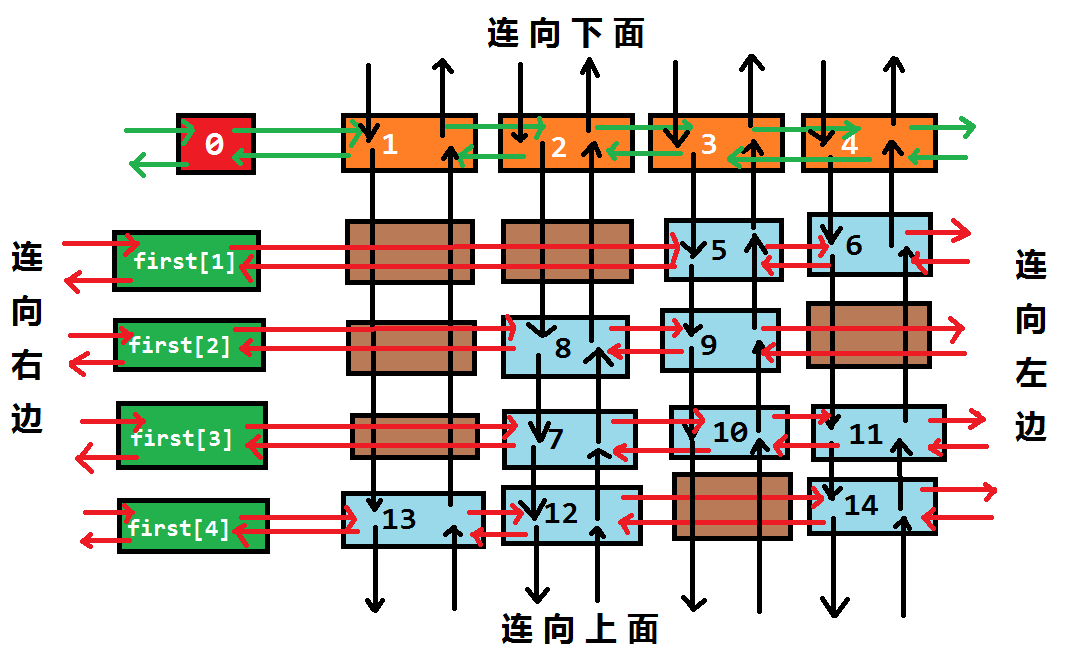$$舞蹈链$$
$引入$
给定$n$个$01$序列
从中选择尽量少的序列
使得每一列恰好有一个$1$(精确覆盖问题)或至少有一个$1$(重复覆盖问题)
这里就需要用$Dacing\ Links$
$十字链表$
对于每一个为$1$的格,表示为一个点
每一行中的$1$的点用$l$,$r$串联
每一列中的$1$的点用$u$,$d$串联

$row[i]$ 为$i$号节点所在行的编号
$col[i]$ 为$i$号节点所在列的编号
$s[y]$ 为第$y$列现有$1$的个数
$精确覆盖问题$
将给定$n$个序列转化成$n$行矩阵
$ \left\( \begin{matrix} 0 & 0 & 1 & 0 & 1 & 1 & 0 \\\ 1 & 0 & 0 & 1 & 0 & 0 & 1 \\\ 0 & 1 & 1 & 0 & 0 & 1 & 0 \\\ 1 & 0 & 0 & 1 & 0 & 0 & 0 \\\ 0 & 1 & 0 & 0 & 0 & 0 & 1 \\\ 0 & 0 & 0 & 1 & 1 & 0 & 1 \\\ \end{matrix} \right\) $
$DLX$ 算法思想和暴力一样:
1.先找到$1$个数少的一列(优化搜索顺序)
这里选第$3$列
$ \left\( \begin{matrix} 0 & 0 & \color{#0000FF}{1} & 0 & 1 & 1 & 0 \\\ 1 & 0 & \color{#0000FF}{0} & 1 & 0 & 0 & 1 \\\ 0 & 1 & \color{#0000FF}{1} & 0 & 0 & 1 & 0 \\\ 1 & 0 & \color{#0000FF}{0} & 1 & 0 & 0 & 0 \\\ 0 & 1 & \color{#0000FF}{0} & 0 & 0 & 0 & 1 \\\ 0 & 0 & \color{#0000FF}{0} & 1 & 1 & 0 & 1 \\\ \end{matrix} \right\) $
2.从这一列所有$1$枚举
这里选择第$3$行
$ \left\( \begin{matrix} 0 & 0 & \color{#0000FF}{1} & 0 & 1 & 1 & 0 \\\ 1 & 0 & \color{#0000FF}{0} & 1 & 0 & 0 & 1 \\\ \color{red}{0} & \color{red}{1} & \color{red}{1} & \color{red}{0} & \color{red}{0} & \color{red}{1} & \color{red}{0} \\\ 1 & 0 & \color{#0000FF}{0} & 1 & 0 & 0 & 0 \\\ 0 & 1 & \color{#0000FF}{0} & 0 & 0 & 0 & 1 \\\ 0 & 0 & \color{#0000FF}{0} & 1 & 1 & 0 & 1 \\\ \end{matrix} \right\) $
3.找出这一行中有$1$的列
$ \left\( \begin{matrix} 0 & \color{green}{0} & \color{#0000FF}{1} & 0 & 1 & \color{green}{1} & 0 \\\ 1 & \color{green}{0} & \color{#0000FF}{0} & 1 & 0 & \color{green}{0} & 1 \\\ \color{red}{0} & \color{red}{1} & \color{red}{1} & \color{red}{0} & \color{red}{0} & \color{red}{1} & \color{red}{0} \\\ 1 & \color{green}{0} & \color{#0000FF}{0} & 1 & 0 & \color{green}{0} & 0 \\\ 0 & \color{green}{1} & \color{#0000FF}{0} & 0 & 0 & \color{green}{0} & 1 \\\ 0 & \color{green}{0} & \color{#0000FF}{0} & 1 & 1 & \color{green}{0} & 1 \\\ \end{matrix} \right\) $
4.将所有有颜色的数删去,得到新的矩阵
$ \left\( \begin{matrix} 0 & 0 & 1 & 0 \\\ 1 & 1 & 0 & 1 \\\ 1 & 1 & 0 & 0 \\\ 0 & 0 & 0 & 1 \\\ 0 & 1 & 1 & 1 \\\ \end{matrix} \right\) $
$精确覆盖问题实现$
#include <bits/stdc++.h>
using namespace std;
const int N = 5510;
int n, m;
int row[N], col[N], s[N];
int l[N], r[N], u[N], d[N], idx;
int ans[N], top;
void init()
{
for (int i = 0; i <= m; i ++ )
{
l[i] = i - 1, r[i] = i + 1;
u[i] = d[i] = i;
}
l[0] = m, r[m] = 0;
idx = m + 1;
}
void add(int& hh, int& tt, int x, int y)
{
row[idx] = x, col[idx] = y, s[y] ++ ;
u[idx] = y, d[idx] = d[y], u[d[y]] = idx, d[y] = idx;
l[tt] = r[hh] = idx, l[idx] = hh, r[idx] = tt;
tt = idx ++ ;
}
void remove(int p)
{
r[l[p]] = r[p], l[r[p]] = l[p];
for (int i = d[p]; i != p; i = d[i])
for (int j = r[i]; j != i; j = r[j])
{
s[col[j]] -- ;
u[d[j]] = u[j], d[u[j]] = d[j];
}
}
void resume(int p)
{
r[l[p]] = p, l[r[p]] = p;
for (int i = d[p]; i != p; i = d[i])
for (int j = r[i]; j != i; j = r[j])
{
u[d[j]] = j, d[u[j]] = j;
s[col[j]] ++ ;
}
}
bool dfs()
{
if (!r[0]) return true;
int p = r[0];
for (int i = r[0]; i; i = r[i])
if (s[i] < s[p])
p = i;
remove(p);
for (int i = d[p]; i != p; i = d[i])
{
ans[++ top] = row[i];
for (int j = r[i]; j != i; j = r[j]) remove(col[j]);
if (dfs()) return true;
for (int j = r[i]; j != i; j = r[j]) resume(col[j]);
top -- ;
}
resume(p);
return false;
}
int main()
{
scanf("%d%d", &n, &m);
init();
for (int i = 1; i <= n; i ++ )
{
int hh = idx, tt = idx;
for (int j = 1; j <= m; j ++ )
{
int x;
scanf("%d", &x);
if (x) add(hh, tt, i, j);
}
}
if (dfs())
{
for (int i = 1; i <= top; i ++ ) printf("%d ", ans[i]);
puts("");
}
else puts("No Solution!");
return 0;
}
$重复覆盖问题$
同理,由于分枝多,运用$IDA*$优化
$重复覆盖问题实现$
#include <bits/stdc++.h>
using namespace std;
const int N = 110, M = N * N;
int n, m;
int row[M], col[M], s[N];
int l[M], r[M], u[M], d[M], idx;
int ans[N];
bool st[N];
void init()
{
for (int i = 0; i <= m; i ++ )
{
l[i] = i - 1;
r[i] = i + 1;
col[i] = u[i] = d[i] = i;
s[i] = 0;
}
l[0] = m, r[m] = 0;
idx = m + 1;
}
void add(int& hh, int& tt, int x, int y)
{
row[idx] = x, col[idx] = y, s[y] ++ ;
u[idx] = y, d[idx] = d[y], u[d[y]] = idx, d[y] = idx;
l[tt] = r[hh] = idx, l[idx] = hh, r[idx] = tt;
tt = idx ++ ;
}
int h()
{
int cnt = 0;
memset(st, 0, sizeof st);
for (int i = r[0]; i; i = r[i])
{
if (st[col[i]]) continue;
cnt ++ ;
st[col[i]] = true;
for (int j = d[i]; j != i; j = d[j])
for (int k = r[j]; k != j; k = r[k])
st[col[k]] = true;
}
return cnt;
}
void remove(int p)
{
for (int i = d[p]; i != p; i = d[i])
{
l[r[i]] = l[i];
r[l[i]] = r[i];
}
}
void resume(int p)
{
for (int i = u[p]; i != p; i = u[i])
{
l[r[i]] = i;
r[l[i]] = i;
}
}
bool dfs(int k, int depth)
{
if (k + h() > depth) return false;
if (!r[0]) return true;
int p = r[0];
for (int i = r[0]; i; i = r[i])
if (s[i] < s[p])
p = i;
for (int i = d[p]; i != p; i = d[i])
{
ans[k] = row[i];
remove(i);
for (int j = r[i]; j != i; j = r[j]) remove(j);
if (dfs(k + 1, depth)) return true;
for (int j = l[i]; j != i; j = l[j]) resume(j);
resume(i);
}
return false;
}
int main()
{
scanf("%d%d", &n, &m);
init();
for (int i = 1; i <= n; i ++ )
{
int hh = idx, tt = idx;
for (int j = 1; j <= m; j ++ )
{
int x;
scanf("%d", &x);
if (x) add(hh, tt, i, j);
}
}
int depth = 0;
while (!dfs(0, depth)) depth ++ ;
printf("%d\n", depth);
for (int i = 0; i < depth; i ++ ) printf("%d ", ans[i]);
return 0;
}

